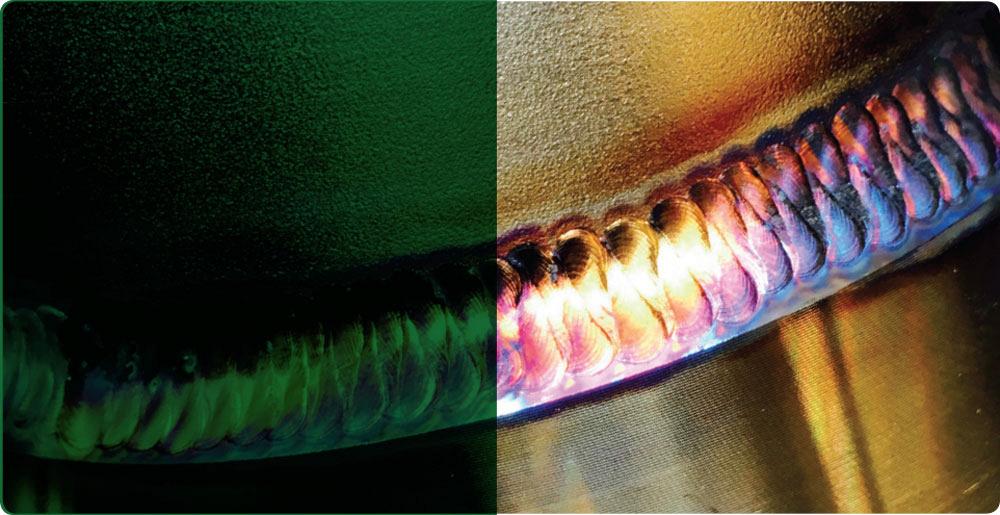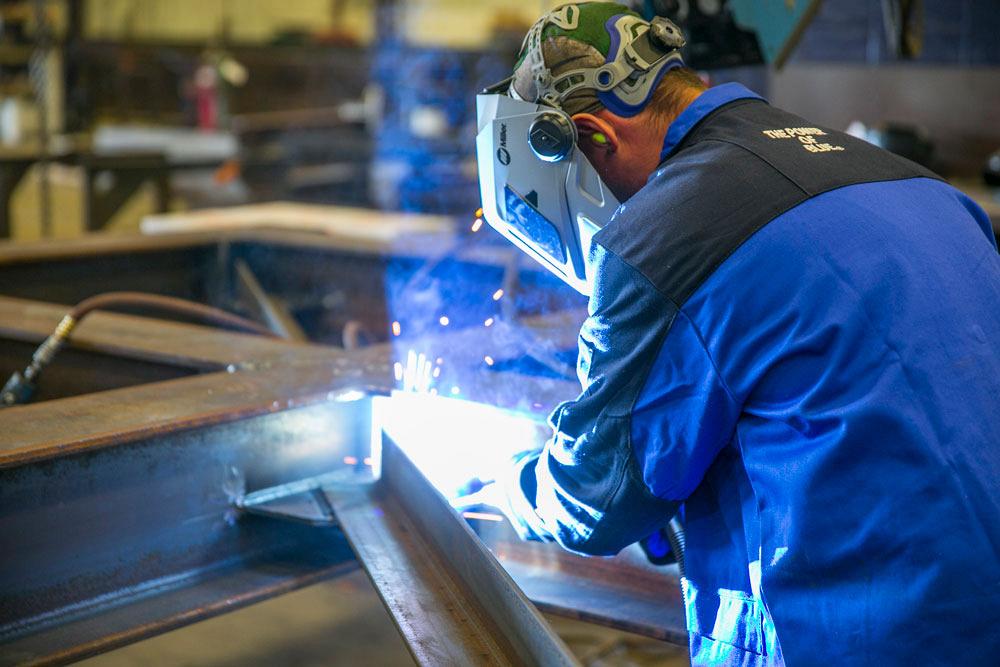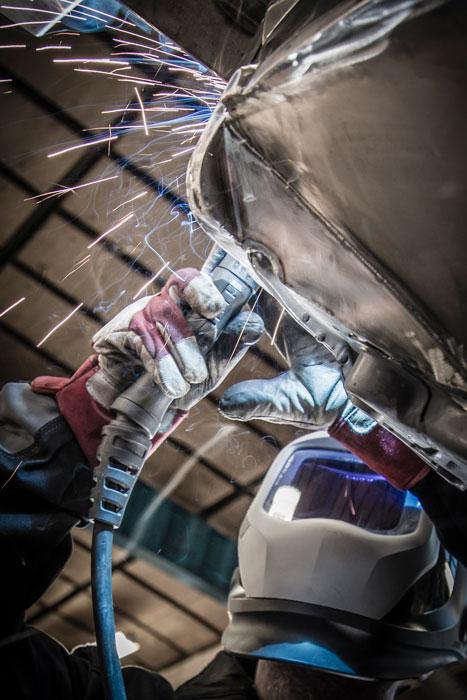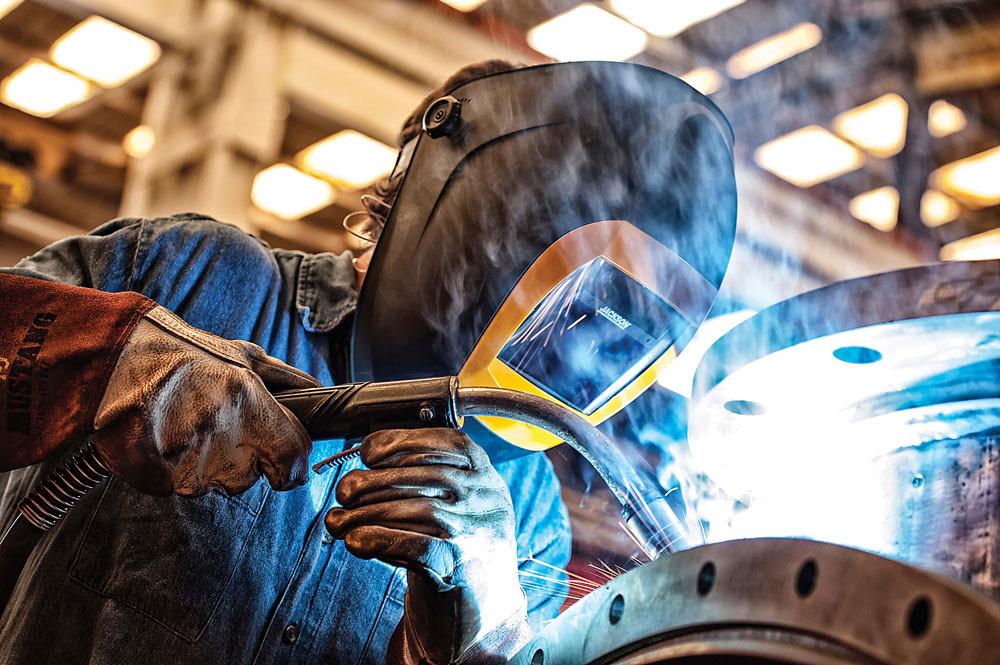Senior Editor
- FMA
- The Fabricator
- FABTECH
- Canadian Metalworking
Categories
- Additive Manufacturing
- Aluminum Welding
- Arc Welding
- Assembly and Joining
- Automation and Robotics
- Bending and Forming
- Consumables
- Cutting and Weld Prep
- Electric Vehicles
- En Español
- Finishing
- Hydroforming
- Laser Cutting
- Laser Welding
- Machining
- Manufacturing Software
- Materials Handling
- Metals/Materials
- Oxyfuel Cutting
- Plasma Cutting
- Power Tools
- Punching and Other Holemaking
- Roll Forming
- Safety
- Sawing
- Shearing
- Shop Management
- Testing and Measuring
- Tube and Pipe Fabrication
- Tube and Pipe Production
- Waterjet Cutting
Industry Directory
Webcasts
Podcasts
FAB 40
Advertise
Subscribe
Account Login
Search
Welding helmets, with color
How new welding helmet lenses let the color through
- By Tim Heston
- January 14, 2019
- Article
- Safety
Welding can be a pain in the neck, literally. The workpiece could have perfect fit-up; the welding consumables and power source could be in perfect shape; the welder could even be welding in the flat position. Yet at the end of a long week the welder’s neck hurts—and it’s thanks to the head nod.
The welder’s head nod should be familiar to anyone who’s toured a weld shop. The welder fixtures his work, gets his welding gun in position, then nods his head to make his welding helmet pivot down into position before he strikes an arc.
Some head nodding is probably unavoidable; it’s the easiest and quickest way for many welders to start laying down a bead. But sometimes a welder may stop welding and lift his helmet midway through a job, even if his helmet has autodarkening technology. Why?
Probably because the world isn’t green.
Autodarkening welding helmets have been around for several decades. Still, when peering through a darkened lens, a welder notices something funny about the world around him. Colors fade away and green dominates.
Until recently a welder had no choice but to adapt. But today a welding helmet’s autodarkening filter (ADF) has evolved to enable a welder to see more colors than ever.
The Anatomy of a Welding Helmet Lens
How has this become possible? To understand this it helps to know exactly what goes into a lens, or more specifically, the layers of material that make up that lens.
Broadly speaking, the polarizers in an ADF acts under the same principle as any polarizing lens—though the light wave manipulation is of course far more complicated on a welding helmet than on your typical pair of sunglasses.
Polarization blocks light waves in a certain polarization orientation. Put on a pair of polarizing sunglasses and look at your smartphone display (which uses polarized filters). Turn your head or rotate the phone, and you’ll see the image on the screen get darker, as fewer waves of light make it through both the phone screen’s filter and your polarized sunglasses. When the screen goes black, the polarization direction of the phone’s filter is perpendicular to the filter on your sunglasses.
“This is cross polarization,” said Marco Koch, CEO and president of Optrel, based in Switzerland. “You have two polarizers and you cross them at 90 degrees, and all the light is blocked.”

Autodarkening filters incorporate multiple layers of polarization filters (shown here with vertical and horizontal lines) and liquid crystal panels. Photo courtesy of 3M.
Welding helmets with ADFs and consumer electronics like smartphones, tablets, and flat-screen TVs share similar roots in liquid crystal technology. When voltage is applied to liquid crystals, their molecules shift and reorient themselves in specific ways. How exactly they orient themselves depends on the strength of the applied electric field.
LCDs in consumer electronics work with a backlight, a perfectly safe light source. Light from a welding arc, of course, isn’t so safe. For this reason, an ADF starts with an ultraviolet (UV) and infrared (IR) filter (also called the band pass filter), which removes dangerous radiation from the get-go. So even if the darkening function fails, a modern ADF helmet that abides by industry standards should be safe to use.
“This is very important to know from a welder’s perspective,” said Bojan Marin, site manager of the Slovenia-based Balder production facility, part of Kimberly-Clark Corp. “The protective level of any autodarkening filter in the open state, the UV and IR protection should be as good as required for the darkest shade. For instance, if the darkest shade is 13, then even if the filter is entirely open, UV and infrared protection should be at the same level as shade 13.” If the ADF doesn’t darken once the arc is struck, a welder may see a bright flash of light, but no permanent harm will be done.
The liquid crystal layers (usually two or more, to reach high levels of shading) are what make an ADF autodarkening. A struck welding arc is detected by sensors on the front of the lens cartridge. These sensors trigger power to be sent from the helmet’s battery (or other source, like solar panels) to the liquid crystal layers, which twist the light waves in a specific manner to darken the window to the required level.
“Liquid crystals are twisted nematics,” Koch explained. Known as TN-cells, the liquid crystals can be realigned precisely by applying very low voltages. “By applying voltage, we change the orientation of the crystal, and by that, we control how much light goes through.”
Over the years the technology has evolved to incorporate different shading for different applications. “For example, when you weld at different amperages, you need different shadings,” Koch said. “So decades ago we started with a single shade, such as ‘shade 11.’ [The higher the number, the darker the shade.] Now, with variable shade options, the technology has evolved to offer multiple shades with the same cartridge. Today we can operate from shade 3 to shade 14.”
Welding in Color
Standing in his FABTECH® show booth in Atlanta in November, Koch pointed to his laptop screen showing the visible light spectrum, from ultraviolet and blue light on the left (short wavelengths) to infrared light on the right (long wavelengths).
A helmet’s most important function has been to protect a welder’s eyes from harmful wavelengths within the electromagnetic spectrum. This includes ultraviolet, blue, infrared, and excessive total amounts of visible light. For dec-ades scientists and engineers have dealt with a challenge: How do you block the dangerous wavelengths completely and yet let as many colors through the lens as you can?
Blocking some light waves but not others is a tricky business. This relates back to Koch’s laptop screen at FABTECH, across which ran a curve with a narrow peak in the middle, right where the green and yellow wavelengths were—the traditional view of a weld through a welding helmet ADF. From there it descends toward zero, going through purple and blue on the left (toward UV) and orange and red on the right (toward IR).
The engineering challenge involves transforming that narrow mountain peak (think Mount Fuji) to one with a wide, flat top (like Devils Tower in Wyoming). This arrangement allows more colors through the lens while at the same time blocking harmful wavelengths and providing appropriate shading.

This image from a laptop screen at Optrel’s FABTECH booth shows an example of the range of colors that a welder can see with today’s autodarkening filters.
“This now has become possible today,” Koch said. “The welder can now see the weld like never before. He can see the details and the colors of the metal, the markings, and what the arc really looks like.”
A greater range of colors “gives welders a clearer view of the weld pool and surrounding workpiece while welding,” said Karena Dyer, product manager, welding safety and health, head and face protection, Miller Electric Mfg. Co., Appleton, Wis. She added that certain lenses are also “designed to reduce eye strain when the operator is not welding, allowing the operator to leave his or her helmet down during preweld setup or finishing work.”
How is this made possible? Kenneth Jarefors, a Sweden-based senior specialist in optics for 3M, explained that much of it has to do with the design of the filters, in which certain wavelengths along the spectrum are reflected while others pass through. “It has to do with the structure inside the filter.”
An ADF’s UV and IR filter, or band pass filters, are absolutely critical. ADFs aren’t safe without them. That’s because the liquid crystal shutters and polarizers cannot adequately filter all the IR and UV that the welding arc generates.
That band pass filter is also the reason that welders see the world as green. As Marin explained, about two decades ago an ADF’s band pass filters let in a range of wavelengths of just 50 nanometers, mainly the green wavelengths—hence, they turned the welder’s world green.
Today some filters can let in wavelengths between 480 nm (blue) all the way up to 720 nm (red). “That’s 150 nm,” Marin said, “which covers all the wavelengths that the human eyes can see.”
For the band pass filter to achieve this, it’s been all about the layers, including the way each is deposited and constructed, and their consistency. Eyeglasses with antireflective coatings might have two or three layers. The band pass filter in a welding helmet ADF can have more than 20, each having a thickness measured in nanometers.
“To get ideal protection against UV, protection against infrared, and transmit as much as possible in the visible spectrum, we need those layers,” Marin said, adding that a little blue and red is still cut off slightly.
“Making the perfect filter isn’t possible,” Jarefors said “There has to be some transition between the high and low end of the visible light spectrum. But we’re getting closer.”
“We need some transition for safety,” Marin added. “The key has been to make the divide between really good transmission [of color] and no transmission as narrow as possible. We need to do this within 20 nm, and that’s why we need so many layers in the band pass filter, to make that transition very sharp.”

Today’s welding helmet lenses let more light wavelengths through for a more colorful view. Image courtesy of Optrel Inc.
Jarefors added that manufacturers’ capability to tune optical properties has led to further enhancements. For instance, soon welders may be able to “tune” their welding helmets to see certain colors better than others.
Reaction Time
Reaction time—that is, the time between striking the arc and the lens darkening—has gotten quicker. Today the transition time can be measured in fractions of a millisecond.
Marin added that reaction times have become so fast that the human eye isn’t able to perceive the differences. “If the reaction time is less than 200 microseconds, your eye won’t be able to tell the difference between one reaction time and another. But what is important is the ability for the electronic circuitry to detect the initial welding spark.”
If sensors and electronics don’t work properly, they won’t instruct the ADF to darken, which means a welder will see a very bright flash when he starts to weld. It’s still safe, thanks to the passive UV/IR filters in the welding helmet, “but it can be annoying,” Marin said.
Now I see
To be sure, optics technology represents just one kind of advancement in welding helmets. The best lenses in the world aren’t worth much if a welder finds the helmet heavy or uncomfortable. Helmets made of lightweight materials have helped make helmets feel more comfortable for more people.
Regardless, few would argue that better, more accurate viewing is paramount. “The ultimate goal is to provide a welding helmet that provides comfort and optimal visibility before, during, and after the arc,” Dyer said.
The science behind welding helmet window design digs deep into materials science and optics, and most of it is incredibly complicated. But the goal is simple: to design a safe helmet that, to the one welding with it, doesn’t feel like he’s welding with a helmet at all. Lighter materials, better designs, and refined approaches to filters are bringing that reality to light.
3M, Personal Safety Division, www.3m.com/speedglas
Kimberly-Clark Professional, Jackson Safety, Balder, www.kcprofessional.com
Optrel Inc., www.optrel.com/en

The better a welder can see, the better his or her weld will be. Photo courtesy of Miller Electric Mfg. Co.
Miller Electric Mfg. Co., www.millerwelds.com
Standards for Optical Clarity
Read welding helmet product literature closely and you’ll notice a series of cryptic numbers—often it’s 1/1/1/2, sometimes it’s 1/1/1/1. Those relate to a European standard on optical clarity of welding lens cartridges called EN 379. The standard spells out a test to evaluate welding lenses using four categories. Each category is rated 1 through 3, with 1 being the highest rating.
Bojan Marin is site manager of the Slovenia-based Balder production facility, part of Kimberly-Clark Corp. As Marin explained, the first three categories in EN 379 were developed initially for traditional welding helmet filters offering passive protection. The fourth was adopted specifically for autodarkening filters (ADFs).
1. Optical quality, which relates to the level of distortion a lens creates. Less distortion obviously is better. To put this in perspective, Marin said, distortion in a welding lens should be below 1/8 diopter to pass industry requirements; a pair of prescription eyeglasses are usually defined to between ¼ and ½ diopter, to correct eyesight to an acceptable level. “1/8 of a diopter is a level of distortation not noticeable by the human eye,” Marin said.
2. Diffusion of light, or scattering. If a welder smudges the lens, he’ll probably see a halo effect around the welding arc. Clean the lens and, in a helmet rated with low levels of inherent scattering, that halo should go away, and the arc should become clear.
3. Homogeneity, or having a consistent shade—that is, the variation between light and dark areas of a lens. Less variation is better.
4. Angular dependence measures how consistent the shade level is when viewed at different angles. As Marin explained, angular dependence wasn’t an issue with traditional, dark-glass welding helmet filters. If you look at a darkened lens at an angle, the image looks darker and the level of shading rises. But look at an angle through a liquid crystal panel, and the shade level can go down and the image can become brighter—which, for welding, can be a problem.
How did manufacturers overcome this issue? “The challenge was to reshape the liquid crystal structure,” Marin said, adding that some ADF technologies use liquid crystals that aren’t standard twisted nematic, which twists light waves by 90 degrees, but instead twist them by higher angles, sometimes above 180 degrees.
Still, technical tweaks to the twist of liquid crystals is just one tool welding helmet manufacturers use to achieve low angular dependence. Other tools include the structure of the liquid crystal filter itself, the precision of the manufacturing process, and the consistency and quality control when building the intricate layers of a modern ADF.
Regarding EN 379, there’s one big caveat: Over the next few years a new ISO standard will likely be published, giving the welding helmet industry an international standard. The details of the standard will be different, but the goal will be the same: to provide the welder with the safest, crispest, most accurate view possible.
About the Author

Tim Heston
2135 Point Blvd
Elgin, IL 60123
815-381-1314
Tim Heston, The Fabricator's senior editor, has covered the metal fabrication industry since 1998, starting his career at the American Welding Society's Welding Journal. Since then he has covered the full range of metal fabrication processes, from stamping, bending, and cutting to grinding and polishing. He joined The Fabricator's staff in October 2007.
subscribe now

The Fabricator is North America's leading magazine for the metal forming and fabricating industry. The magazine delivers the news, technical articles, and case histories that enable fabricators to do their jobs more efficiently. The Fabricator has served the industry since 1970.
start your free subscription- Stay connected from anywhere

Easily access valuable industry resources now with full access to the digital edition of The Fabricator.

Easily access valuable industry resources now with full access to the digital edition of The Welder.

Easily access valuable industry resources now with full access to the digital edition of The Tube and Pipe Journal.
- Podcasting
- Podcast:
- The Fabricator Podcast
- Published:
- 04/16/2024
- Running Time:
- 63:29
In this episode of The Fabricator Podcast, Caleb Chamberlain, co-founder and CEO of OSH Cut, discusses his company’s...
- Trending Articles
AI, machine learning, and the future of metal fabrication

Employee ownership: The best way to ensure engagement

Steel industry reacts to Nucor’s new weekly published HRC price

How to set a press brake backgauge manually

Capturing, recording equipment inspection data for FMEA

- Industry Events
16th Annual Safety Conference
- April 30 - May 1, 2024
- Elgin,
Pipe and Tube Conference
- May 21 - 22, 2024
- Omaha, NE
World-Class Roll Forming Workshop
- June 5 - 6, 2024
- Louisville, KY
Advanced Laser Application Workshop
- June 25 - 27, 2024
- Novi, MI




























